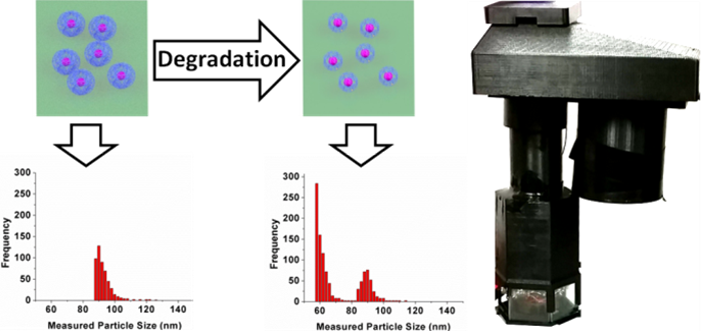Holographic microscope provides a new tool for nanomedicine to rapidly measure degradation of drug loaded nanoparticles

UCLA researchers have developed a cost-effective method to rapidly monitor the degradation of drug-carrying nanoparticles using a chip-scale microscope. This nanoparticle characterization platform is based on holography and can accurately monitor the size changes of nanocapsules undergoing degradation, while releasing the contents of their drug cargo. This research provides scientists with a powerful measurement tool that can be used to design better nanocapsules for drug delivery and other nanomedicine-related applications.
Nanotechnology has gained practical importance, including in drug delivery. The global market for nanomedicine is estimated to reach $350 billion USD by 2025. Design and synthesis of degradable nanoparticles are very important in drug delivery and nanomedicine fields. Although accurate assessment of nanoparticle degradation rates would improve the characterization and optimization of drug delivery vehicles, traditional approaches that are used to monitor drug release from nanoparticles and nanocapsules rely on using advanced technology such as electron microscopy, dynamic light scattering, or other biochemical methods, all of which have drawbacks and practical limitations. Most of these instruments are expensive, and do not have the ability to monitor nanoparticle degradation in real time.
UCLA's holographic imaging method, on the other hand, has an accuracy close to the higher-end measurement devices, but at a fraction of their cost and complexity. It was built using 3-D printed parts and comprises low-cost optical elements, forming a chip-scale optical microscope that weighs about a pound and can be operated using any desktop or laptop computer. This holographic nanoparticle characterization tool can be used to measure the size of individual nanoparticles over a wide range of particle densities, from a few tens to tens of thousands of nanoparticles per micro-liter, and can detect nanoparticles as small as ~40 nm.
"Through this collaboration between my lab and Professor Tatiana Segura's lab at UCLA, we have created a powerful and cost-effective computational method that enables high-throughput monitoring of the degradation of any type of nanoparticle using an extremely small sample volume that is at least 1000-fold smaller than what is required by other optical techniques, providing additional cost savings per measurement," said Aydogan Ozcan, who led the research team and is UCLA's Chancellor's Professor of Electrical Engineering and Bioengineering and associate director of the California NanoSystems Institute (CNSI).
Dr. Ozcan and his collaborator, Dr. Segura from the Chemical and Biomolecular Engineering Department at UCLA, along with postdoctoral scholars, Drs. Aniruddha Ray and Shuoran Li, utilized this holographic imaging method to characterize a polymer-based nanocapsule system used to deliver vascular endothelial growth factor, a protein that can help in stroke recovery and wound healing. Growth factors are especially critical for regular cell function and their incorporation within therapeutic nanomaterials has been a major focus of recent research, making this new holographic nanoparticle characterization tool very timely.
More information: Aniruddha Ray et al. High-Throughput Quantification of Nanoparticle Degradation Using Computational Microscopy and Its Application to Drug Delivery Nanocapsules, ACS Photonics (2017). DOI: 10.1021/acsphotonics.7b00122
Journal information: ACS Photonics
Provided by UCLA Ozcan Research Group





















